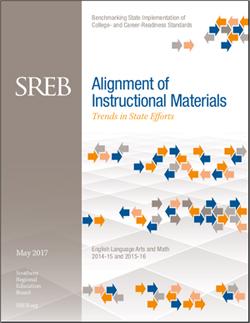Heavy Lift
Aligning Classroom Materials to State Standards
SREB report can serve as a guide as work continues
Big changes don’t happen overnight. And when states adopted higher education standards, it was only the first step in a long-term effort to improve schools so all students graduate high school with what they need to be ready for college and careers.
Next came the complex work of implementing the standards. Schools needed textbooks, curricula and lesson plans designed with the new standards in mind. Teachers needed training to shift their classroom strategies to help students meet the readiness standards. States had to choose assessments that show how students are doing along their way. And all these efforts had to be coordinated at every level — from state departments of education to local school districts to individual schools and classrooms.
States have made huge progress. And the work continues.
Focus on areas your state could improve – and what you can learn from states with strong efforts in those areas.
Through SREB’s multi-year project to gather information and analyze implementation practices, we’ve immersed ourselves in how states are carrying out these important efforts. Most recently, we focused on how state departments of education help schools align classroom materials to the standards.
After states adopted new standards for college and career readiness, it became clear that educators would need to sort through an overwhelming wave of new instructional materials. When publishers claimed their materials were aligned to the state’s new standards, local educators were not necessarily equipped to verify the claims. Nor did states have tools or processes in place to identify high-quality materials that aligned to the new standards. States faced the challenge of providing recommendations and supporting local school leaders as they selected instructional materials.
 Our latest report, Alignment of
Instructional Materials: Trends in State Efforts,
highlights notable state efforts and provides detailed accounts
of what’s working in the region. We hope it will inspire states
to build on their work in new and creative ways.
Our latest report, Alignment of
Instructional Materials: Trends in State Efforts,
highlights notable state efforts and provides detailed accounts
of what’s working in the region. We hope it will inspire states
to build on their work in new and creative ways.
In particular, the “look-fors” table in the appendix lays out what comprehensive support could look like and can serve as a compass toward better support for educators. It outlines criteria in three high-leverage areas, which SREB and a panel of expert advisors from participating states and national organizations determined were essential to the work.
- Establish clear and consistent criteria for identifying high-quality, standards-aligned instructional materials.
- Support local efforts to identify and use aligned instructional materials. Equip teachers and leaders at the local level to choose what meets their needs – or create their own materials.
- Use data to continuously improve state efforts.
The regional report identifies trends in the work across the states, highlights exemplary efforts and recommends actions to strengthen state work across the region. Individual state profiles identify each state’s efforts in these areas as minimal, essential or strong, describe the state’s efforts and recommend actions to strengthen that state’s efforts.
Here are a few takeaways for state leaders and educators as they continue this work.
First, concentrating on these three areas can yield robust support for educators and real results for states.
Second, focus on areas your state could improve – and what you can learn from states with strong efforts in those areas. Remember that this isn’t a “one-and-done” proposition. Aligning classroom materials to standards requires monitoring and re-evaluation.
And finally, we hope our report serves as a reminder that you’re not alone. Educators across the SREB region are working to solve similar challenges, and we can all learn from one another.

